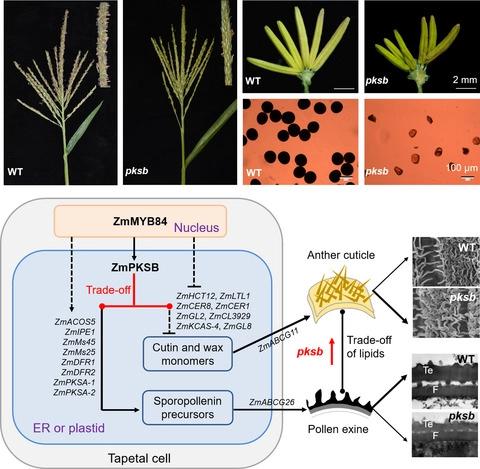当前位置:
X-MOL 学术
›
Plant Biotech. J.
›
论文详情
Our official English website, www.x-mol.net, welcomes your feedback! (Note: you will need to create a separate account there.)
The ZmMYB84-ZmPKSB regulatory module controls male fertility through modulating anther cuticle—pollen exine trade-off in maize anthers
Plant Biotechnology Journal ( IF 13.8 ) Pub Date : 2022-08-16 , DOI: 10.1111/pbi.13911 Xinze Liu 1, 2 , Yilin Jiang 1, 2 , Suowei Wu 1, 2, 3 , Jing Wang 1, 2 , Chaowei Fang 1, 2 , Shaowei Zhang 1, 2 , Rongrong Xie 1, 2 , Lina Zhao 1, 2 , Xueli An 1, 2, 3 , Xiangyuan Wan 1, 2, 3
Plant Biotechnology Journal ( IF 13.8 ) Pub Date : 2022-08-16 , DOI: 10.1111/pbi.13911 Xinze Liu 1, 2 , Yilin Jiang 1, 2 , Suowei Wu 1, 2, 3 , Jing Wang 1, 2 , Chaowei Fang 1, 2 , Shaowei Zhang 1, 2 , Rongrong Xie 1, 2 , Lina Zhao 1, 2 , Xueli An 1, 2, 3 , Xiangyuan Wan 1, 2, 3
Affiliation

|
Anther cuticle and pollen exine are two crucial lipid layers that ensure normal pollen development and pollen–stigma interaction for successful fertilization and seed production in plants. Their formation processes share certain common pathways of lipid biosynthesis and transport across four anther wall layers. However, molecular mechanism underlying a trade-off of lipid-metabolic products to promote the proper formation of the two lipid layers remains elusive. Here, we identified and characterized a maize male-sterility mutant pksb, which displayed denser anther cuticle but thinner pollen exine as well as delayed tapetal degeneration compared with its wild type. Based on map-based cloning and CRISPR/Cas9 mutagenesis, we found that the causal gene (ZmPKSB) of pksb mutant encoded an endoplasmic reticulum (ER)-localized polyketide synthase (PKS) with catalytic activities to malonyl-CoA and midchain-fatty acyl-CoA to generate triketide and tetraketide α-pyrone. A conserved catalytic triad (C171, H320 and N353) was essential for its enzymatic activity. ZmPKSB was specifically expressed in maize anthers from stages S8b to S9-10 with its peak at S9 and was directly activated by a transcription factor ZmMYB84. Moreover, loss function of ZmMYB84 resulted in denser anther cuticle but thinner pollen exine similar to the pksb mutant. The ZmMYB84-ZmPKSB regulatory module controlled a trade-off between anther cuticle and pollen exine formation by altering expression of a series of genes related to biosynthesis and transport of sporopollenin, cutin and wax. These findings provide new insights into the fine-tuning regulation of lipid-metabolic balance to precisely promote anther cuticle and pollen exine formation in plants.
中文翻译:

ZmMYB84-ZmPKSB 调节模块通过调节花药角质层控制雄性生育力——玉米花药中的花粉外壁权衡
花药角质层和花粉外壁是两个重要的脂质层,可确保正常的花粉发育和花粉 - 柱头相互作用,以确保植物成功受精和种子生产。它们的形成过程共享脂质生物合成和跨四个花药壁层运输的某些共同途径。然而,脂质代谢产物的权衡以促进两个脂质层的正确形成的分子机制仍然难以捉摸。在这里,我们鉴定并表征了一个玉米雄性不育突变体pksb,与野生型相比,它显示出更致密的花药角质层但更薄的花粉外壁以及延迟的绒毡层退化。基于图谱克隆和 CRISPR/Cas9 诱变,我们发现 pksb 的致病基因( ZmPKSB )突变体编码内质网 (ER) 定位的聚酮合酶 (PKS),该酶对丙二酰辅酶 A 和中链脂肪酰基辅酶 A 具有催化活性,可生成三酮化合物和四酮化合物 α-吡喃酮。保守的催化三联体(C171、H320 和 N353)对其酶活性至关重要。ZmPKSB在 S8b 至 S9-10 期的玉米花药中特异性表达,其峰值在 S9,并由转录因子 ZmMYB84 直接激活。此外,ZmMYB84 的功能丧失导致与pksb突变体相似的花药角质层更致密但花粉外壁更薄。ZmMYB84- ZmPKSB调节模块通过改变一系列与孢粉素、角质和蜡质的生物合成和运输相关的基因的表达来控制花药角质层和花粉外壁形成之间的权衡。这些发现为脂质代谢平衡的微调调节提供了新的见解,以精确促进植物中花药角质层和花粉外壁的形成。
更新日期:2022-08-16
中文翻译:

ZmMYB84-ZmPKSB 调节模块通过调节花药角质层控制雄性生育力——玉米花药中的花粉外壁权衡
花药角质层和花粉外壁是两个重要的脂质层,可确保正常的花粉发育和花粉 - 柱头相互作用,以确保植物成功受精和种子生产。它们的形成过程共享脂质生物合成和跨四个花药壁层运输的某些共同途径。然而,脂质代谢产物的权衡以促进两个脂质层的正确形成的分子机制仍然难以捉摸。在这里,我们鉴定并表征了一个玉米雄性不育突变体pksb,与野生型相比,它显示出更致密的花药角质层但更薄的花粉外壁以及延迟的绒毡层退化。基于图谱克隆和 CRISPR/Cas9 诱变,我们发现 pksb 的致病基因( ZmPKSB )突变体编码内质网 (ER) 定位的聚酮合酶 (PKS),该酶对丙二酰辅酶 A 和中链脂肪酰基辅酶 A 具有催化活性,可生成三酮化合物和四酮化合物 α-吡喃酮。保守的催化三联体(C171、H320 和 N353)对其酶活性至关重要。ZmPKSB在 S8b 至 S9-10 期的玉米花药中特异性表达,其峰值在 S9,并由转录因子 ZmMYB84 直接激活。此外,ZmMYB84 的功能丧失导致与pksb突变体相似的花药角质层更致密但花粉外壁更薄。ZmMYB84- ZmPKSB调节模块通过改变一系列与孢粉素、角质和蜡质的生物合成和运输相关的基因的表达来控制花药角质层和花粉外壁形成之间的权衡。这些发现为脂质代谢平衡的微调调节提供了新的见解,以精确促进植物中花药角质层和花粉外壁的形成。



























 京公网安备 11010802027423号
京公网安备 11010802027423号